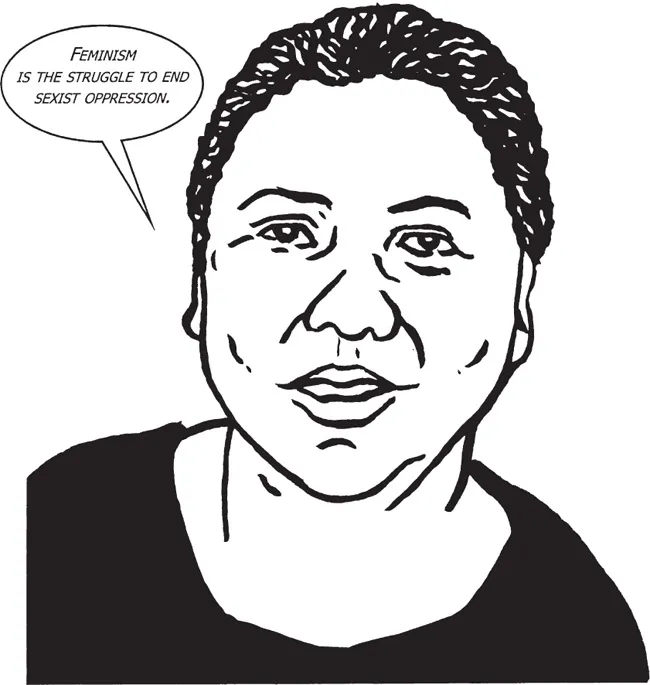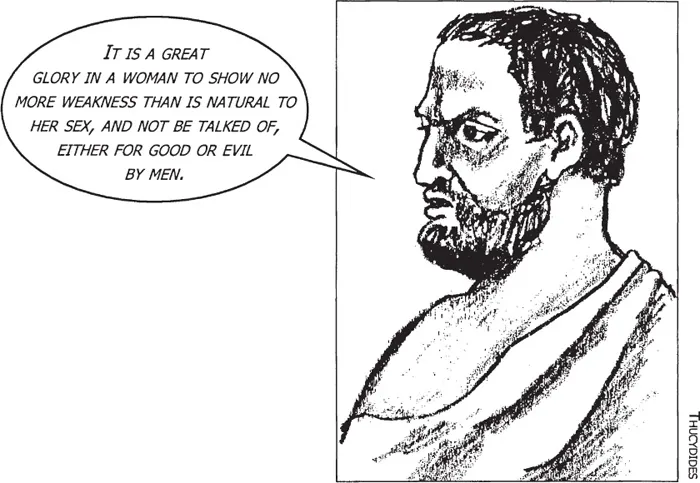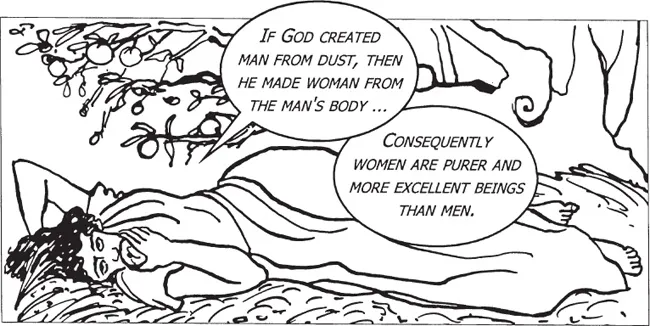
eBook - ePub
Introducing Feminism
A Graphic Guide
Cathia Jenainati, Judy Groves
This is a test
Partager le livre
- 176 pages
- English
- ePUB (adapté aux mobiles)
- Disponible sur iOS et Android
eBook - ePub
Introducing Feminism
A Graphic Guide
Cathia Jenainati, Judy Groves
Détails du livre
Aperçu du livre
Table des matières
Citations
À propos de ce livre
The term 'feminism' came into English usage around the 1890s, but women's conscious struggle to resist discrimination and sexist oppression goes much further back. This completely new and updated edition of "Introducing Feminism" surveys the major developments that have affected women's lives from the 17th century to the present day. "Introducing Feminism" is an invaluable reference book for anyone seeking the story of how feminism reconfigured the world for women and men alike.
Foire aux questions
Comment puis-je résilier mon abonnement ?
Il vous suffit de vous rendre dans la section compte dans paramètres et de cliquer sur « Résilier l’abonnement ». C’est aussi simple que cela ! Une fois que vous aurez résilié votre abonnement, il restera actif pour le reste de la période pour laquelle vous avez payé. Découvrez-en plus ici.
Puis-je / comment puis-je télécharger des livres ?
Pour le moment, tous nos livres en format ePub adaptés aux mobiles peuvent être téléchargés via l’application. La plupart de nos PDF sont également disponibles en téléchargement et les autres seront téléchargeables très prochainement. Découvrez-en plus ici.
Quelle est la différence entre les formules tarifaires ?
Les deux abonnements vous donnent un accès complet à la bibliothèque et à toutes les fonctionnalités de Perlego. Les seules différences sont les tarifs ainsi que la période d’abonnement : avec l’abonnement annuel, vous économiserez environ 30 % par rapport à 12 mois d’abonnement mensuel.
Qu’est-ce que Perlego ?
Nous sommes un service d’abonnement à des ouvrages universitaires en ligne, où vous pouvez accéder à toute une bibliothèque pour un prix inférieur à celui d’un seul livre par mois. Avec plus d’un million de livres sur plus de 1 000 sujets, nous avons ce qu’il vous faut ! Découvrez-en plus ici.
Prenez-vous en charge la synthèse vocale ?
Recherchez le symbole Écouter sur votre prochain livre pour voir si vous pouvez l’écouter. L’outil Écouter lit le texte à haute voix pour vous, en surlignant le passage qui est en cours de lecture. Vous pouvez le mettre sur pause, l’accélérer ou le ralentir. Découvrez-en plus ici.
Est-ce que Introducing Feminism est un PDF/ePUB en ligne ?
Oui, vous pouvez accéder à Introducing Feminism par Cathia Jenainati, Judy Groves en format PDF et/ou ePUB ainsi qu’à d’autres livres populaires dans Social Sciences et Feminism & Feminist Theory. Nous disposons de plus d’un million d’ouvrages à découvrir dans notre catalogue.
Informations
Sujet
Social SciencesSous-sujet
Feminism & Feminist TheoryWhat is Feminism?
Any attempt to “introduce feminism” invariably faces numerous challenges. Where to start, who to include, what to leave out and when to stop are all important considerations. This book provides an overview of the development of feminist activism in the Anglo-speaking world. It specifically outlines feminist thought in Britain and the US, although it refers to international contexts where relevant.
The book acknowledges and intends to celebrate the variety of feminist perspectives which have developed throughout women’s history, taking as its premise bell hooks’ famous definition.

FEMINISM IS THE STRUGGLE TO END SEXIST OPPRESSION.
Introducing Feminism traces the historical and social development of this struggle.
What is Patriarchy?
One starting point for thinking about feminist activity is coming to a consensus about what the term “patriarchy” means. A useful definition is provided by Chris Weedon.

“PATRIARCHAL REFERS TO POWER RELATIONS IN WHICH WOMEN’S INTERESTS ARE SUBORDINATED TO THE INTERESTS OF MEN.”
“THESE POWER RELATIONS TAKE ON MANY FORMS, FROM THE SEXUAL DIVISION OF LABOUR AND THE SOCIAL ORGANIZATION OF PROCREATION TO THE INTERNALIZED NORMS OF FEMINITY BY WHICH WE LIVE.”
“PATRIARCHAL POWER RESTS ON SOCIAL GIVEN TO BIOLOGICAL SEXUAL DIFFERENCE.”
“THESE POWER RELATIONS TAKE ON MANY FORMS, FROM THE SEXUAL DIVISION OF LABOUR AND THE SOCIAL ORGANIZATION OF PROCREATION TO THE INTERNALIZED NORMS OF FEMINITY BY WHICH WE LIVE.”
“PATRIARCHAL POWER RESTS ON SOCIAL GIVEN TO BIOLOGICAL SEXUAL DIFFERENCE.”
The term “feminism” came into English usage around the 1890s, but women’s conscious struggle to resist discrimination and sexist oppression goes much further back.
Biology is Destiny
As early as the 4th century BC, Aristotle (384–322 BC) declared that “women were women by virtue of a certain lack of qualities”. His predecessor the Greek historian and army general Thucydides (c. 460–400 BC) had some advice for women.

IT IS A GREAT GLORY IN A WOMAN TO SHOW NO MORE WEAKNESS THAN IS NATURAL TO HER SEX, AND NOT BE TALKED OF, EITHER FOR GOOD OR EVIL BY MEN.
Early thinking about the difference between women and men was based on essentialist ideas about gender which maintained that women’s and men’s differences are a result of biology. The belief that biology is destiny suggests that, in comparable situations, men exhibit “masculine” psychological traits such as aggressiveness, rationality and assertiveness, whereas women will exhibit “feminine” traits such as gentleness, intuitiveness and sensitivity. These differences, it was believed, translated into particular patterns of thought, feeling and behaviour specific to each gender.
Logic or Emotion?
Essentialism sees men as able to think logically, abstractly and analytically, while women are mainly emotional, compassionate and nurturing creatures.

IT IS IMPORTANT TO MAINTAIN DISTINCTIONS BETWEEN THE SEXES IN ORDER TO PRESERVE THE NATURAL ORDER.
Essentialist thinking had repercussions on women’s private and public lives. In private, essentialist ideas were translated into rule sof conduct for the woman as wife, mother and daughter. In public, it was believed that women’s participation should be limited and strictly controlled by a masculine representative of authority such as husband, father, the clergy, the law.

Essentialist ideas about women permeated Western thought for centuries and proposed that there is a natural, biologically determined essence of the feminine that is universal and unchangeable.
Feminists have long fought to dispel such myths about gender.
Early Modern Feminist Activity
Early Modern (1550–1700) English society was founded on the rule of the father.

MAN IS THE HEAD OF THE HOUSEHOLD ...
... JUST AS THE MONARCH IS THE HEAD OF STATE AND JESUS HEAD OF THE CHURCH.
... JUST AS THE MONARCH IS THE HEAD OF STATE AND JESUS HEAD OF THE CHURCH.
Women had no formal rights and were not represented in the law. Even if some women were able to receive a higher education, they were not allowed to receive the degree for which they studied. In marriage, the woman’s body belonged to her husband, who was also the only legal guardian of the children.
Early Modern feminist activity aimed at challenging the prevalent social view that women are weak and irrational creatures who should be controlled by men. There were a number of political events which supported such efforts, in particular Queen Elizabeth I’s accession to the throne in 1558 and her long and successful reign as a single female.

THEN THERE WAS THE ENGLISH CIVIL WAR AND THE INTERREGNUM PERIOD OF 1642–60 AND THE GLORIOUS REVOLUTION OF 1688...
THESE EVENTS QUESTIONED THE SUPREME POWER OF THE KING AND DEMONSTRATED THAT IT WAS POSSIBLE TO CHALLENGE PATRIARCHAL RULE.
THESE EVENTS QUESTIONED THE SUPREME POWER OF THE KING AND DEMONSTRATED THAT IT WAS POSSIBLE TO CHALLENGE PATRIARCHAL RULE.
Reinterpreting the Bible
Writing on women’s issues in the late 16th century began to proliferate, with a number of essays challenging the ideal of the female as “chaste, silent and obedient”. In 1589, Jane Anger’s Her Protection for Women reinterpreted Genesis.

IF GOD CREATED MAN FROM DUST, THEN HE MADE WOMAN FROM THE MAN’S BODY ...
CONSEQUENTLY WOMEN ARE PURER AND MORE EXCELLENT BEINGS THAN MEN.
CONSEQUENTLY WOMEN ARE PURER AND MORE EXCELLENT BEINGS THAN MEN.
Rachel Speght’s A Muzzle for Melastomus (1617) questioned the story of Adam’s fall from the Garden of Eden, taking issue with the underlying assumption that Adam had been seduced by Eve to eat the apple: “If Adam has not approved of that deed which Eve has done, and been willing to tread the steps which she had gone, he being her head would have reproved her.”
The gender of authors such as Jane Anger, Rachel Speght, Esther Sowernam and Sarah Egerton remains debatable. Some crit...